SUSS SWK290 Programme Evaluation: Mental Health Discussion Questions
VerifiedAdded on 2022/09/30
|10
|2281
|22
Homework Assignment
AI Summary
This assignment delves into the critical public health issues of bullying, aggression, and violence, as defined by the World Health Organization. It analyzes a research paper that explores interventions aimed at addressing these problems in schools, specifically focusing on the "Learning Together" program. The assignment examines the researchers' identification of the problem, their proposed interventions (including whole-school policies and restorative practices), and the state of evidence supporting these interventions. It also outlines the hypotheses made by the authors regarding the program's impact, the study's design (a cluster randomized trial), and the methods used for process evaluation, such as thematic content analysis, descriptive statistics, and questionnaires. Furthermore, the assignment details the primary and secondary outcomes of the study, including the effectiveness of the intervention in reducing bullying and aggression, particularly among boys. The findings highlight the significance of a whole-school approach in transforming the environment to improve mental health and reduce aggressive behaviors, emphasizing the program's cost-effectiveness and potential for widespread implementation.
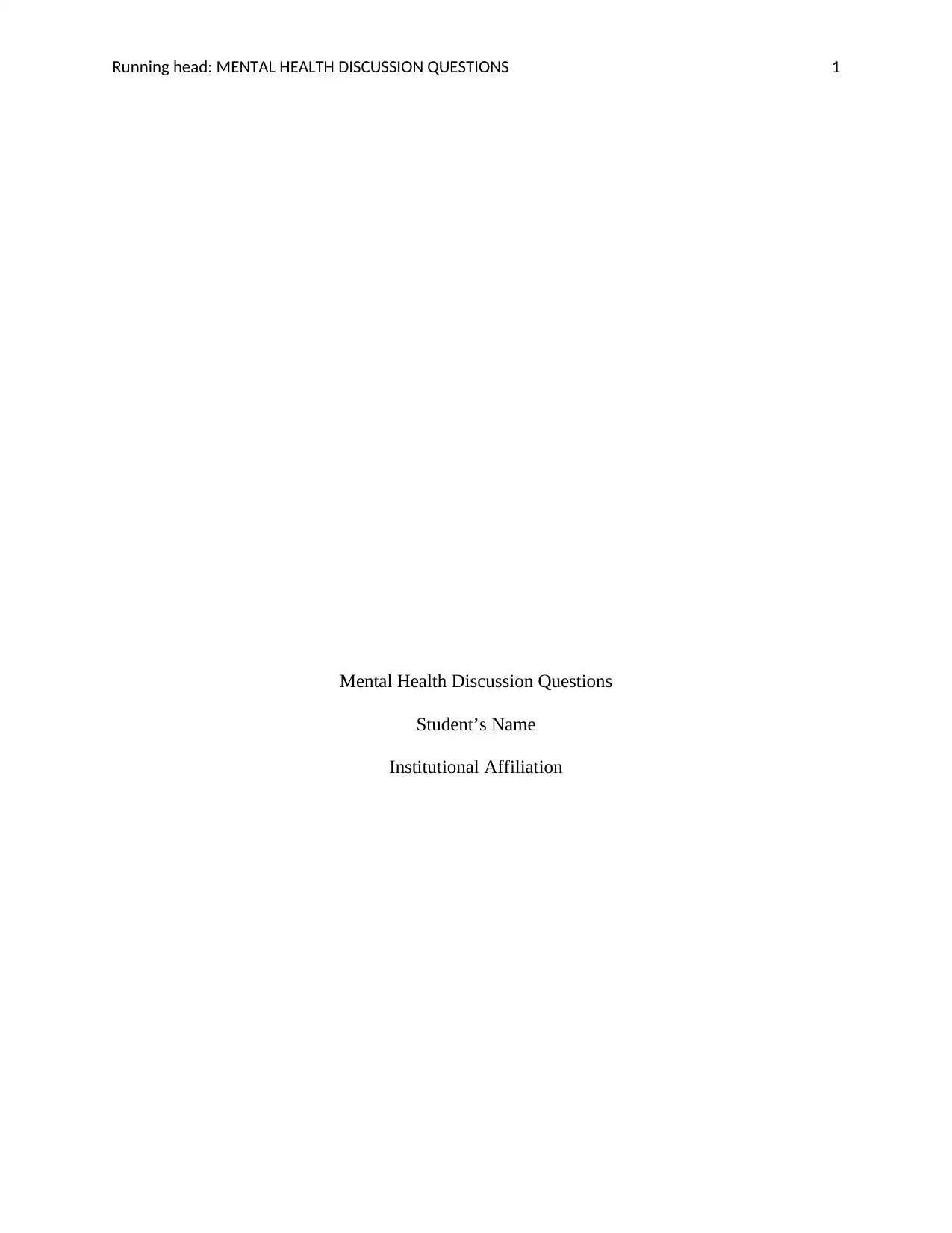
Running head: MENTAL HEALTH DISCUSSION QUESTIONS 1
Mental Health Discussion Questions
Student’s Name
Institutional Affiliation
Mental Health Discussion Questions
Student’s Name
Institutional Affiliation
Paraphrase This Document
Need a fresh take? Get an instant paraphrase of this document with our AI Paraphraser
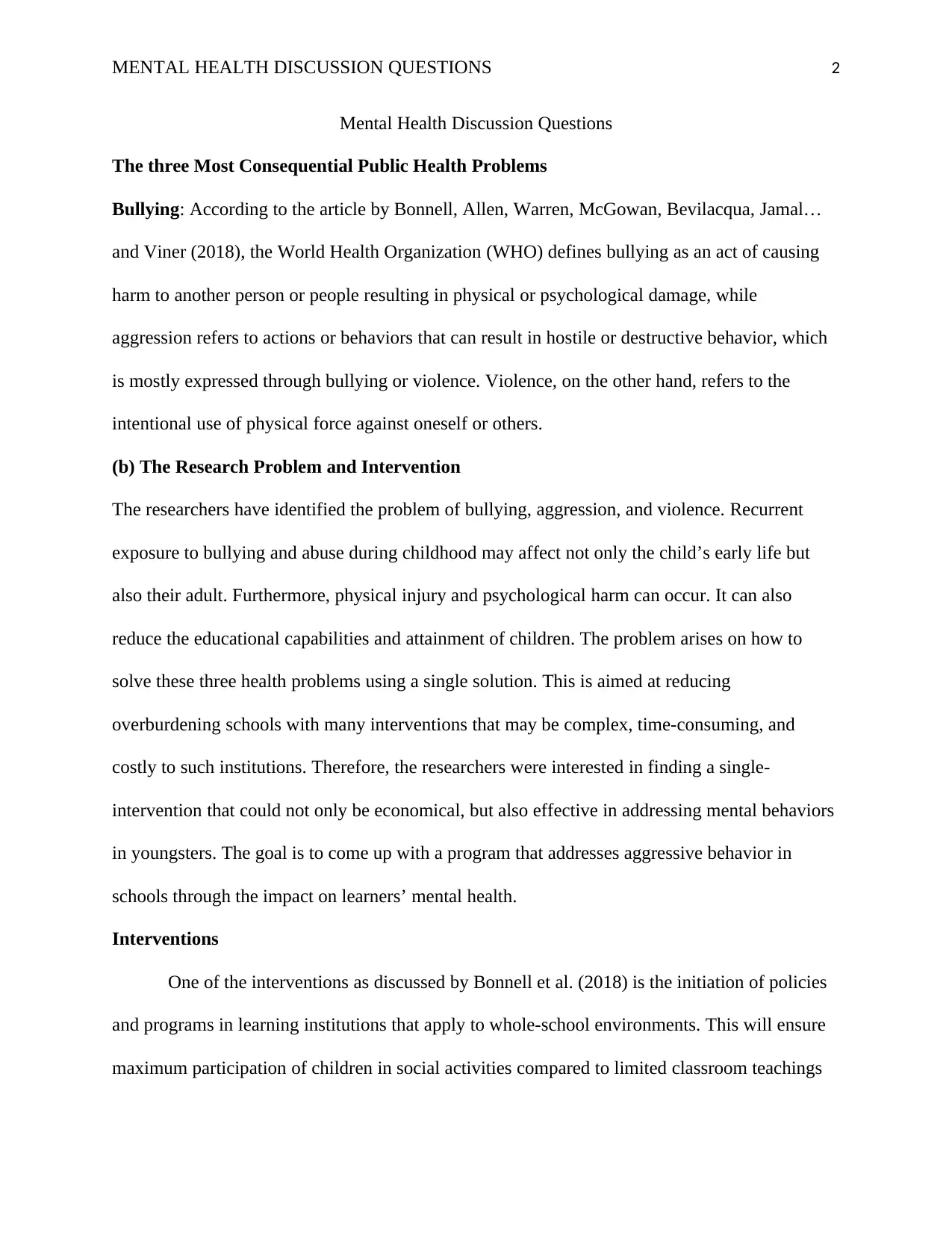
MENTAL HEALTH DISCUSSION QUESTIONS 2
Mental Health Discussion Questions
The three Most Consequential Public Health Problems
Bullying: According to the article by Bonnell, Allen, Warren, McGowan, Bevilacqua, Jamal…
and Viner (2018), the World Health Organization (WHO) defines bullying as an act of causing
harm to another person or people resulting in physical or psychological damage, while
aggression refers to actions or behaviors that can result in hostile or destructive behavior, which
is mostly expressed through bullying or violence. Violence, on the other hand, refers to the
intentional use of physical force against oneself or others.
(b) The Research Problem and Intervention
The researchers have identified the problem of bullying, aggression, and violence. Recurrent
exposure to bullying and abuse during childhood may affect not only the child’s early life but
also their adult. Furthermore, physical injury and psychological harm can occur. It can also
reduce the educational capabilities and attainment of children. The problem arises on how to
solve these three health problems using a single solution. This is aimed at reducing
overburdening schools with many interventions that may be complex, time-consuming, and
costly to such institutions. Therefore, the researchers were interested in finding a single-
intervention that could not only be economical, but also effective in addressing mental behaviors
in youngsters. The goal is to come up with a program that addresses aggressive behavior in
schools through the impact on learners’ mental health.
Interventions
One of the interventions as discussed by Bonnell et al. (2018) is the initiation of policies
and programs in learning institutions that apply to whole-school environments. This will ensure
maximum participation of children in social activities compared to limited classroom teachings
Mental Health Discussion Questions
The three Most Consequential Public Health Problems
Bullying: According to the article by Bonnell, Allen, Warren, McGowan, Bevilacqua, Jamal…
and Viner (2018), the World Health Organization (WHO) defines bullying as an act of causing
harm to another person or people resulting in physical or psychological damage, while
aggression refers to actions or behaviors that can result in hostile or destructive behavior, which
is mostly expressed through bullying or violence. Violence, on the other hand, refers to the
intentional use of physical force against oneself or others.
(b) The Research Problem and Intervention
The researchers have identified the problem of bullying, aggression, and violence. Recurrent
exposure to bullying and abuse during childhood may affect not only the child’s early life but
also their adult. Furthermore, physical injury and psychological harm can occur. It can also
reduce the educational capabilities and attainment of children. The problem arises on how to
solve these three health problems using a single solution. This is aimed at reducing
overburdening schools with many interventions that may be complex, time-consuming, and
costly to such institutions. Therefore, the researchers were interested in finding a single-
intervention that could not only be economical, but also effective in addressing mental behaviors
in youngsters. The goal is to come up with a program that addresses aggressive behavior in
schools through the impact on learners’ mental health.
Interventions
One of the interventions as discussed by Bonnell et al. (2018) is the initiation of policies
and programs in learning institutions that apply to whole-school environments. This will ensure
maximum participation of children in social activities compared to limited classroom teachings
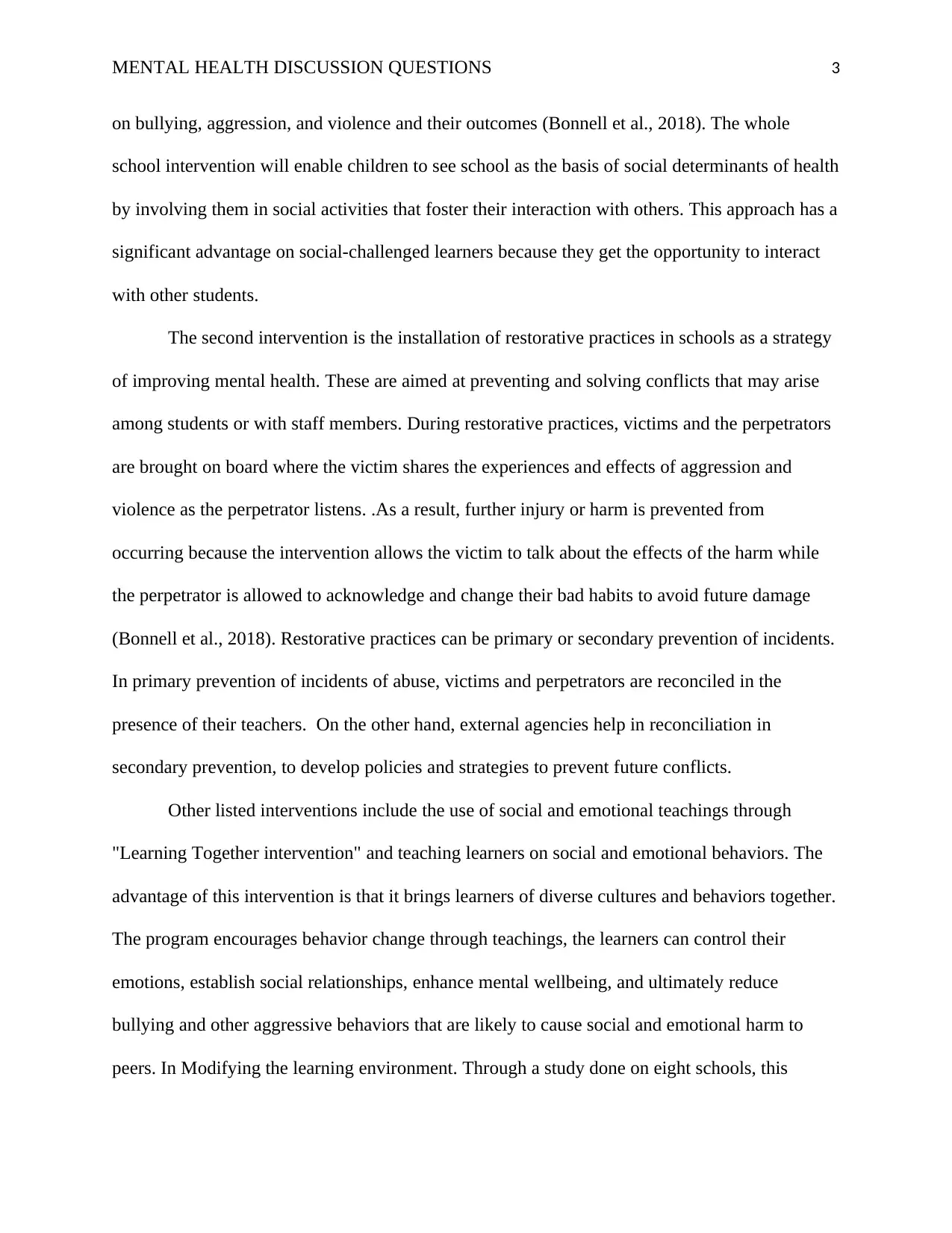
MENTAL HEALTH DISCUSSION QUESTIONS 3
on bullying, aggression, and violence and their outcomes (Bonnell et al., 2018). The whole
school intervention will enable children to see school as the basis of social determinants of health
by involving them in social activities that foster their interaction with others. This approach has a
significant advantage on social-challenged learners because they get the opportunity to interact
with other students.
The second intervention is the installation of restorative practices in schools as a strategy
of improving mental health. These are aimed at preventing and solving conflicts that may arise
among students or with staff members. During restorative practices, victims and the perpetrators
are brought on board where the victim shares the experiences and effects of aggression and
violence as the perpetrator listens. .As a result, further injury or harm is prevented from
occurring because the intervention allows the victim to talk about the effects of the harm while
the perpetrator is allowed to acknowledge and change their bad habits to avoid future damage
(Bonnell et al., 2018). Restorative practices can be primary or secondary prevention of incidents.
In primary prevention of incidents of abuse, victims and perpetrators are reconciled in the
presence of their teachers. On the other hand, external agencies help in reconciliation in
secondary prevention, to develop policies and strategies to prevent future conflicts.
Other listed interventions include the use of social and emotional teachings through
"Learning Together intervention" and teaching learners on social and emotional behaviors. The
advantage of this intervention is that it brings learners of diverse cultures and behaviors together.
The program encourages behavior change through teachings, the learners can control their
emotions, establish social relationships, enhance mental wellbeing, and ultimately reduce
bullying and other aggressive behaviors that are likely to cause social and emotional harm to
peers. In Modifying the learning environment. Through a study done on eight schools, this
on bullying, aggression, and violence and their outcomes (Bonnell et al., 2018). The whole
school intervention will enable children to see school as the basis of social determinants of health
by involving them in social activities that foster their interaction with others. This approach has a
significant advantage on social-challenged learners because they get the opportunity to interact
with other students.
The second intervention is the installation of restorative practices in schools as a strategy
of improving mental health. These are aimed at preventing and solving conflicts that may arise
among students or with staff members. During restorative practices, victims and the perpetrators
are brought on board where the victim shares the experiences and effects of aggression and
violence as the perpetrator listens. .As a result, further injury or harm is prevented from
occurring because the intervention allows the victim to talk about the effects of the harm while
the perpetrator is allowed to acknowledge and change their bad habits to avoid future damage
(Bonnell et al., 2018). Restorative practices can be primary or secondary prevention of incidents.
In primary prevention of incidents of abuse, victims and perpetrators are reconciled in the
presence of their teachers. On the other hand, external agencies help in reconciliation in
secondary prevention, to develop policies and strategies to prevent future conflicts.
Other listed interventions include the use of social and emotional teachings through
"Learning Together intervention" and teaching learners on social and emotional behaviors. The
advantage of this intervention is that it brings learners of diverse cultures and behaviors together.
The program encourages behavior change through teachings, the learners can control their
emotions, establish social relationships, enhance mental wellbeing, and ultimately reduce
bullying and other aggressive behaviors that are likely to cause social and emotional harm to
peers. In Modifying the learning environment. Through a study done on eight schools, this
⊘ This is a preview!⊘
Do you want full access?
Subscribe today to unlock all pages.

Trusted by 1+ million students worldwide
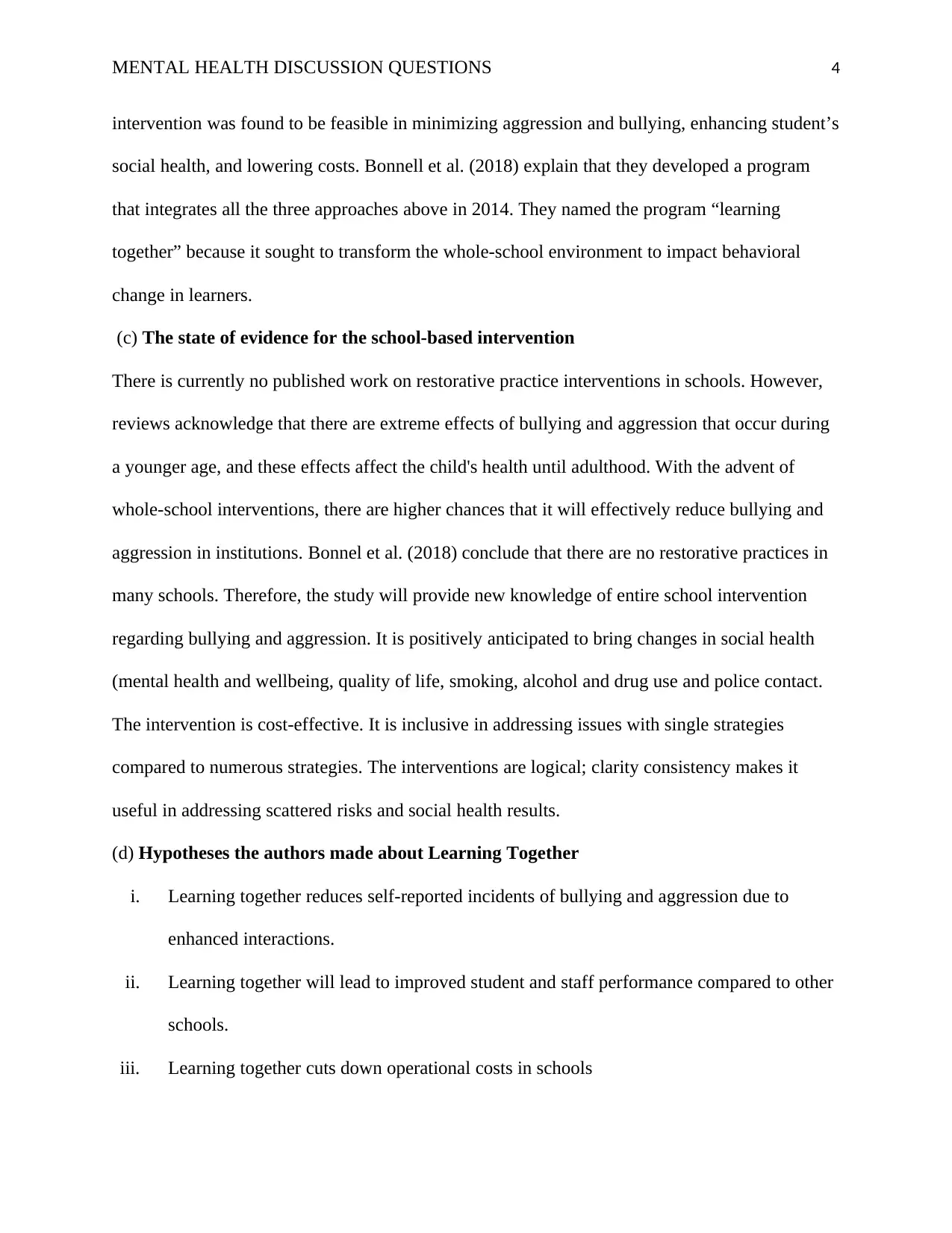
MENTAL HEALTH DISCUSSION QUESTIONS 4
intervention was found to be feasible in minimizing aggression and bullying, enhancing student’s
social health, and lowering costs. Bonnell et al. (2018) explain that they developed a program
that integrates all the three approaches above in 2014. They named the program “learning
together” because it sought to transform the whole-school environment to impact behavioral
change in learners.
(c) The state of evidence for the school-based intervention
There is currently no published work on restorative practice interventions in schools. However,
reviews acknowledge that there are extreme effects of bullying and aggression that occur during
a younger age, and these effects affect the child's health until adulthood. With the advent of
whole-school interventions, there are higher chances that it will effectively reduce bullying and
aggression in institutions. Bonnel et al. (2018) conclude that there are no restorative practices in
many schools. Therefore, the study will provide new knowledge of entire school intervention
regarding bullying and aggression. It is positively anticipated to bring changes in social health
(mental health and wellbeing, quality of life, smoking, alcohol and drug use and police contact.
The intervention is cost-effective. It is inclusive in addressing issues with single strategies
compared to numerous strategies. The interventions are logical; clarity consistency makes it
useful in addressing scattered risks and social health results.
(d) Hypotheses the authors made about Learning Together
i. Learning together reduces self-reported incidents of bullying and aggression due to
enhanced interactions.
ii. Learning together will lead to improved student and staff performance compared to other
schools.
iii. Learning together cuts down operational costs in schools
intervention was found to be feasible in minimizing aggression and bullying, enhancing student’s
social health, and lowering costs. Bonnell et al. (2018) explain that they developed a program
that integrates all the three approaches above in 2014. They named the program “learning
together” because it sought to transform the whole-school environment to impact behavioral
change in learners.
(c) The state of evidence for the school-based intervention
There is currently no published work on restorative practice interventions in schools. However,
reviews acknowledge that there are extreme effects of bullying and aggression that occur during
a younger age, and these effects affect the child's health until adulthood. With the advent of
whole-school interventions, there are higher chances that it will effectively reduce bullying and
aggression in institutions. Bonnel et al. (2018) conclude that there are no restorative practices in
many schools. Therefore, the study will provide new knowledge of entire school intervention
regarding bullying and aggression. It is positively anticipated to bring changes in social health
(mental health and wellbeing, quality of life, smoking, alcohol and drug use and police contact.
The intervention is cost-effective. It is inclusive in addressing issues with single strategies
compared to numerous strategies. The interventions are logical; clarity consistency makes it
useful in addressing scattered risks and social health results.
(d) Hypotheses the authors made about Learning Together
i. Learning together reduces self-reported incidents of bullying and aggression due to
enhanced interactions.
ii. Learning together will lead to improved student and staff performance compared to other
schools.
iii. Learning together cuts down operational costs in schools
Paraphrase This Document
Need a fresh take? Get an instant paraphrase of this document with our AI Paraphraser
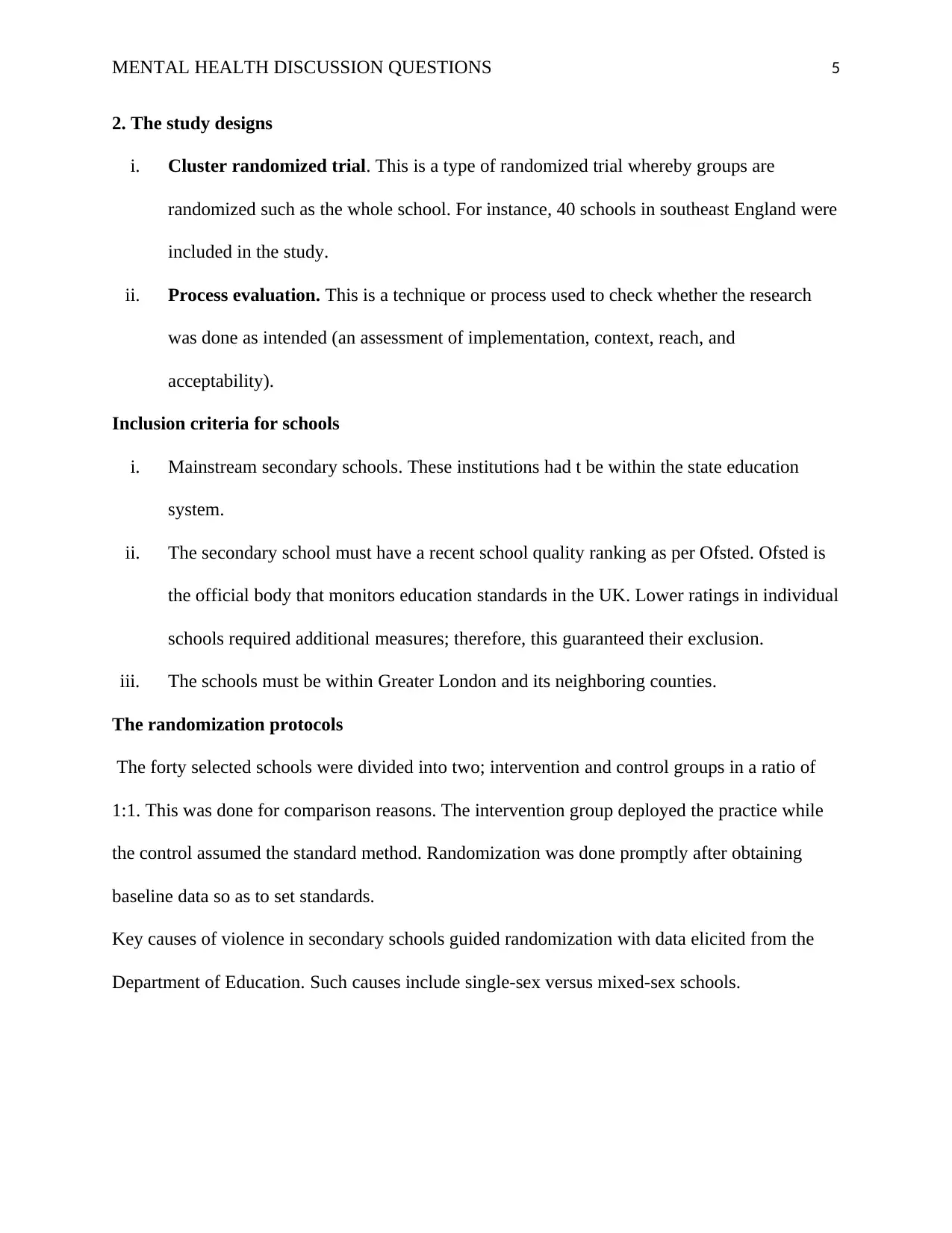
MENTAL HEALTH DISCUSSION QUESTIONS 5
2. The study designs
i. Cluster randomized trial. This is a type of randomized trial whereby groups are
randomized such as the whole school. For instance, 40 schools in southeast England were
included in the study.
ii. Process evaluation. This is a technique or process used to check whether the research
was done as intended (an assessment of implementation, context, reach, and
acceptability).
Inclusion criteria for schools
i. Mainstream secondary schools. These institutions had t be within the state education
system.
ii. The secondary school must have a recent school quality ranking as per Ofsted. Ofsted is
the official body that monitors education standards in the UK. Lower ratings in individual
schools required additional measures; therefore, this guaranteed their exclusion.
iii. The schools must be within Greater London and its neighboring counties.
The randomization protocols
The forty selected schools were divided into two; intervention and control groups in a ratio of
1:1. This was done for comparison reasons. The intervention group deployed the practice while
the control assumed the standard method. Randomization was done promptly after obtaining
baseline data so as to set standards.
Key causes of violence in secondary schools guided randomization with data elicited from the
Department of Education. Such causes include single-sex versus mixed-sex schools.
2. The study designs
i. Cluster randomized trial. This is a type of randomized trial whereby groups are
randomized such as the whole school. For instance, 40 schools in southeast England were
included in the study.
ii. Process evaluation. This is a technique or process used to check whether the research
was done as intended (an assessment of implementation, context, reach, and
acceptability).
Inclusion criteria for schools
i. Mainstream secondary schools. These institutions had t be within the state education
system.
ii. The secondary school must have a recent school quality ranking as per Ofsted. Ofsted is
the official body that monitors education standards in the UK. Lower ratings in individual
schools required additional measures; therefore, this guaranteed their exclusion.
iii. The schools must be within Greater London and its neighboring counties.
The randomization protocols
The forty selected schools were divided into two; intervention and control groups in a ratio of
1:1. This was done for comparison reasons. The intervention group deployed the practice while
the control assumed the standard method. Randomization was done promptly after obtaining
baseline data so as to set standards.
Key causes of violence in secondary schools guided randomization with data elicited from the
Department of Education. Such causes include single-sex versus mixed-sex schools.
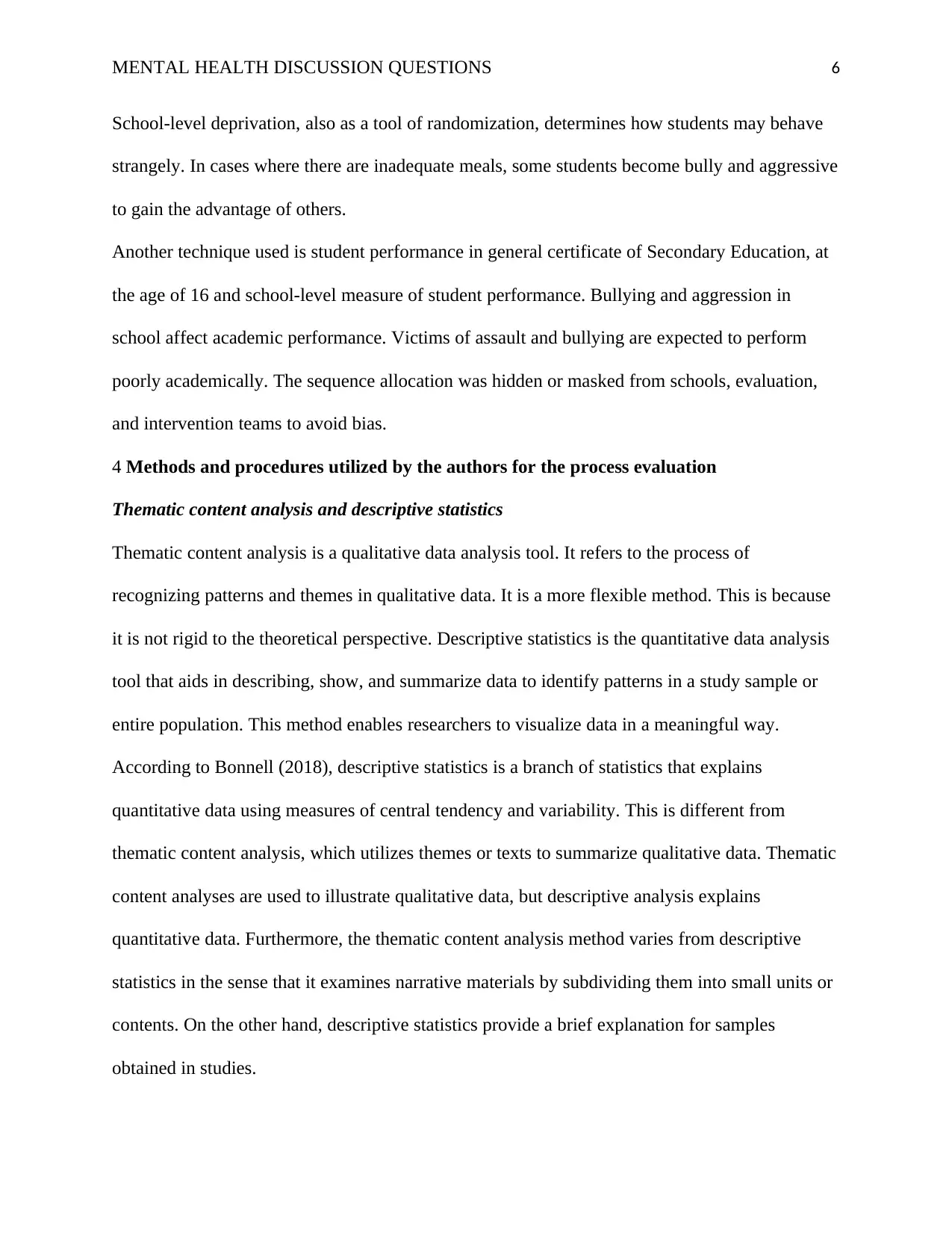
MENTAL HEALTH DISCUSSION QUESTIONS 6
School-level deprivation, also as a tool of randomization, determines how students may behave
strangely. In cases where there are inadequate meals, some students become bully and aggressive
to gain the advantage of others.
Another technique used is student performance in general certificate of Secondary Education, at
the age of 16 and school-level measure of student performance. Bullying and aggression in
school affect academic performance. Victims of assault and bullying are expected to perform
poorly academically. The sequence allocation was hidden or masked from schools, evaluation,
and intervention teams to avoid bias.
4 Methods and procedures utilized by the authors for the process evaluation
Thematic content analysis and descriptive statistics
Thematic content analysis is a qualitative data analysis tool. It refers to the process of
recognizing patterns and themes in qualitative data. It is a more flexible method. This is because
it is not rigid to the theoretical perspective. Descriptive statistics is the quantitative data analysis
tool that aids in describing, show, and summarize data to identify patterns in a study sample or
entire population. This method enables researchers to visualize data in a meaningful way.
According to Bonnell (2018), descriptive statistics is a branch of statistics that explains
quantitative data using measures of central tendency and variability. This is different from
thematic content analysis, which utilizes themes or texts to summarize qualitative data. Thematic
content analyses are used to illustrate qualitative data, but descriptive analysis explains
quantitative data. Furthermore, the thematic content analysis method varies from descriptive
statistics in the sense that it examines narrative materials by subdividing them into small units or
contents. On the other hand, descriptive statistics provide a brief explanation for samples
obtained in studies.
School-level deprivation, also as a tool of randomization, determines how students may behave
strangely. In cases where there are inadequate meals, some students become bully and aggressive
to gain the advantage of others.
Another technique used is student performance in general certificate of Secondary Education, at
the age of 16 and school-level measure of student performance. Bullying and aggression in
school affect academic performance. Victims of assault and bullying are expected to perform
poorly academically. The sequence allocation was hidden or masked from schools, evaluation,
and intervention teams to avoid bias.
4 Methods and procedures utilized by the authors for the process evaluation
Thematic content analysis and descriptive statistics
Thematic content analysis is a qualitative data analysis tool. It refers to the process of
recognizing patterns and themes in qualitative data. It is a more flexible method. This is because
it is not rigid to the theoretical perspective. Descriptive statistics is the quantitative data analysis
tool that aids in describing, show, and summarize data to identify patterns in a study sample or
entire population. This method enables researchers to visualize data in a meaningful way.
According to Bonnell (2018), descriptive statistics is a branch of statistics that explains
quantitative data using measures of central tendency and variability. This is different from
thematic content analysis, which utilizes themes or texts to summarize qualitative data. Thematic
content analyses are used to illustrate qualitative data, but descriptive analysis explains
quantitative data. Furthermore, the thematic content analysis method varies from descriptive
statistics in the sense that it examines narrative materials by subdividing them into small units or
contents. On the other hand, descriptive statistics provide a brief explanation for samples
obtained in studies.
⊘ This is a preview!⊘
Do you want full access?
Subscribe today to unlock all pages.

Trusted by 1+ million students worldwide
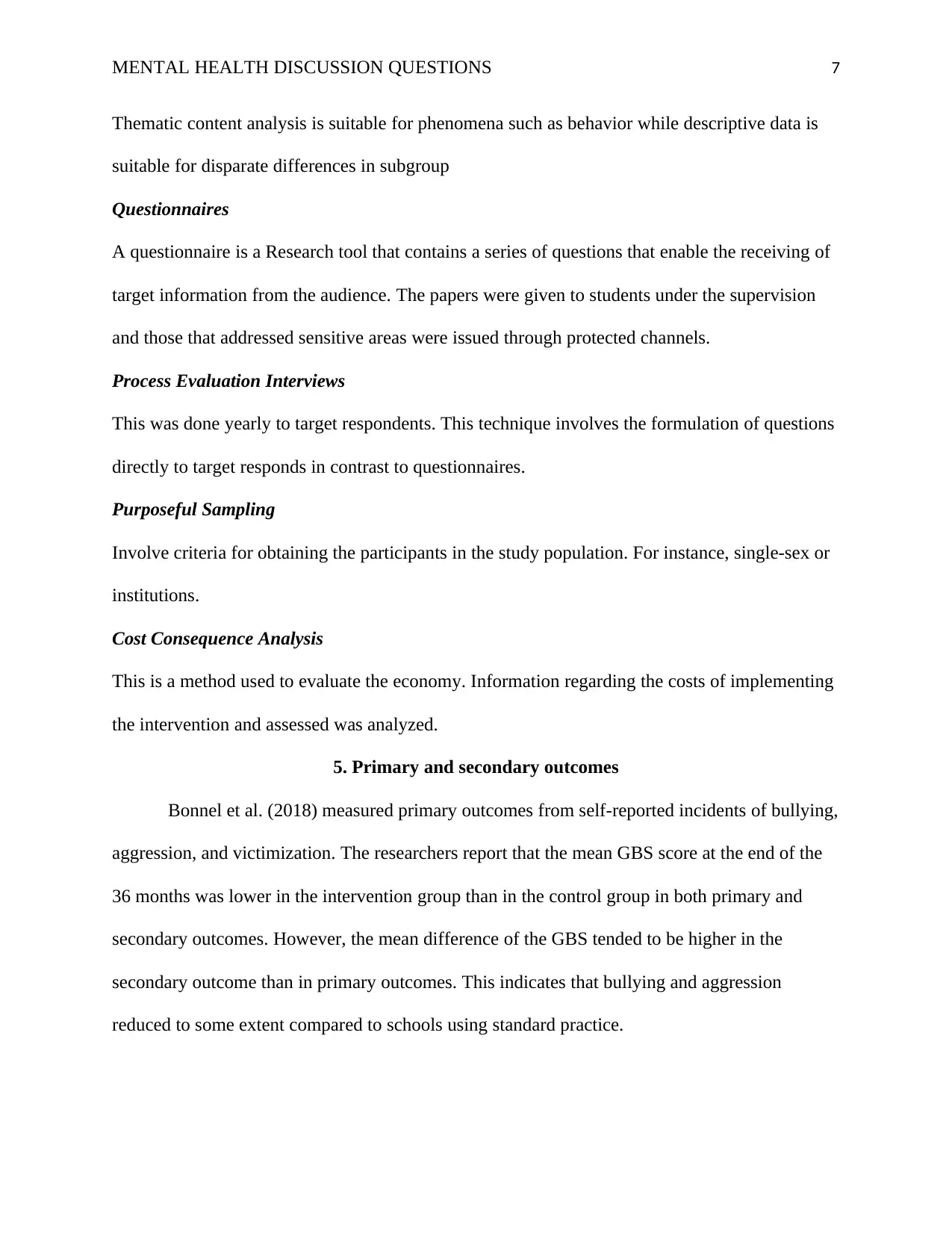
MENTAL HEALTH DISCUSSION QUESTIONS 7
Thematic content analysis is suitable for phenomena such as behavior while descriptive data is
suitable for disparate differences in subgroup
Questionnaires
A questionnaire is a Research tool that contains a series of questions that enable the receiving of
target information from the audience. The papers were given to students under the supervision
and those that addressed sensitive areas were issued through protected channels.
Process Evaluation Interviews
This was done yearly to target respondents. This technique involves the formulation of questions
directly to target responds in contrast to questionnaires.
Purposeful Sampling
Involve criteria for obtaining the participants in the study population. For instance, single-sex or
institutions.
Cost Consequence Analysis
This is a method used to evaluate the economy. Information regarding the costs of implementing
the intervention and assessed was analyzed.
5. Primary and secondary outcomes
Bonnel et al. (2018) measured primary outcomes from self-reported incidents of bullying,
aggression, and victimization. The researchers report that the mean GBS score at the end of the
36 months was lower in the intervention group than in the control group in both primary and
secondary outcomes. However, the mean difference of the GBS tended to be higher in the
secondary outcome than in primary outcomes. This indicates that bullying and aggression
reduced to some extent compared to schools using standard practice.
Thematic content analysis is suitable for phenomena such as behavior while descriptive data is
suitable for disparate differences in subgroup
Questionnaires
A questionnaire is a Research tool that contains a series of questions that enable the receiving of
target information from the audience. The papers were given to students under the supervision
and those that addressed sensitive areas were issued through protected channels.
Process Evaluation Interviews
This was done yearly to target respondents. This technique involves the formulation of questions
directly to target responds in contrast to questionnaires.
Purposeful Sampling
Involve criteria for obtaining the participants in the study population. For instance, single-sex or
institutions.
Cost Consequence Analysis
This is a method used to evaluate the economy. Information regarding the costs of implementing
the intervention and assessed was analyzed.
5. Primary and secondary outcomes
Bonnel et al. (2018) measured primary outcomes from self-reported incidents of bullying,
aggression, and victimization. The researchers report that the mean GBS score at the end of the
36 months was lower in the intervention group than in the control group in both primary and
secondary outcomes. However, the mean difference of the GBS tended to be higher in the
secondary outcome than in primary outcomes. This indicates that bullying and aggression
reduced to some extent compared to schools using standard practice.
Paraphrase This Document
Need a fresh take? Get an instant paraphrase of this document with our AI Paraphraser
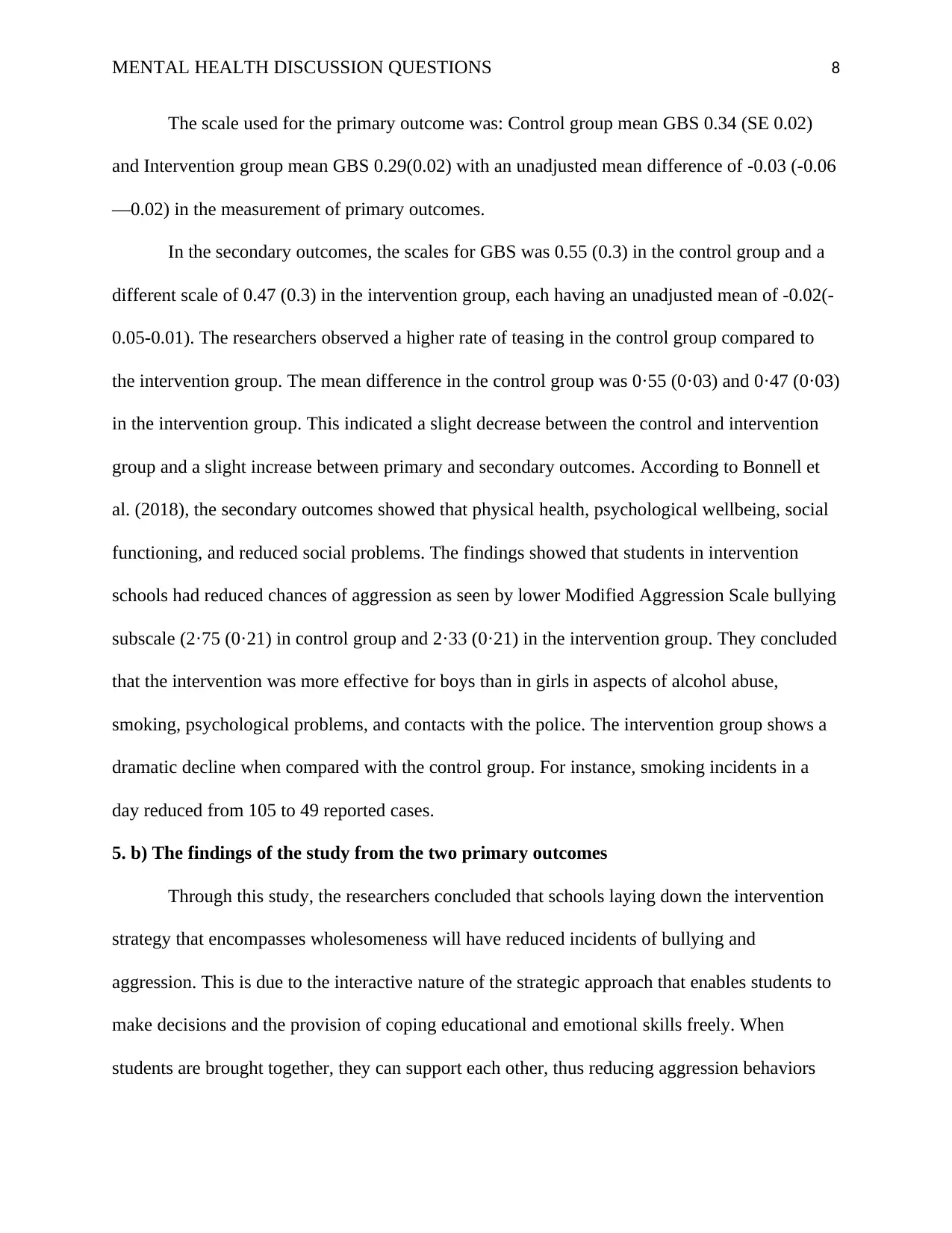
MENTAL HEALTH DISCUSSION QUESTIONS 8
The scale used for the primary outcome was: Control group mean GBS 0.34 (SE 0.02)
and Intervention group mean GBS 0.29(0.02) with an unadjusted mean difference of -0.03 (-0.06
—0.02) in the measurement of primary outcomes.
In the secondary outcomes, the scales for GBS was 0.55 (0.3) in the control group and a
different scale of 0.47 (0.3) in the intervention group, each having an unadjusted mean of -0.02(-
0.05-0.01). The researchers observed a higher rate of teasing in the control group compared to
the intervention group. The mean difference in the control group was 0·55 (0·03) and 0·47 (0·03)
in the intervention group. This indicated a slight decrease between the control and intervention
group and a slight increase between primary and secondary outcomes. According to Bonnell et
al. (2018), the secondary outcomes showed that physical health, psychological wellbeing, social
functioning, and reduced social problems. The findings showed that students in intervention
schools had reduced chances of aggression as seen by lower Modified Aggression Scale bullying
subscale (2·75 (0·21) in control group and 2·33 (0·21) in the intervention group. They concluded
that the intervention was more effective for boys than in girls in aspects of alcohol abuse,
smoking, psychological problems, and contacts with the police. The intervention group shows a
dramatic decline when compared with the control group. For instance, smoking incidents in a
day reduced from 105 to 49 reported cases.
5. b) The findings of the study from the two primary outcomes
Through this study, the researchers concluded that schools laying down the intervention
strategy that encompasses wholesomeness will have reduced incidents of bullying and
aggression. This is due to the interactive nature of the strategic approach that enables students to
make decisions and the provision of coping educational and emotional skills freely. When
students are brought together, they can support each other, thus reducing aggression behaviors
The scale used for the primary outcome was: Control group mean GBS 0.34 (SE 0.02)
and Intervention group mean GBS 0.29(0.02) with an unadjusted mean difference of -0.03 (-0.06
—0.02) in the measurement of primary outcomes.
In the secondary outcomes, the scales for GBS was 0.55 (0.3) in the control group and a
different scale of 0.47 (0.3) in the intervention group, each having an unadjusted mean of -0.02(-
0.05-0.01). The researchers observed a higher rate of teasing in the control group compared to
the intervention group. The mean difference in the control group was 0·55 (0·03) and 0·47 (0·03)
in the intervention group. This indicated a slight decrease between the control and intervention
group and a slight increase between primary and secondary outcomes. According to Bonnell et
al. (2018), the secondary outcomes showed that physical health, psychological wellbeing, social
functioning, and reduced social problems. The findings showed that students in intervention
schools had reduced chances of aggression as seen by lower Modified Aggression Scale bullying
subscale (2·75 (0·21) in control group and 2·33 (0·21) in the intervention group. They concluded
that the intervention was more effective for boys than in girls in aspects of alcohol abuse,
smoking, psychological problems, and contacts with the police. The intervention group shows a
dramatic decline when compared with the control group. For instance, smoking incidents in a
day reduced from 105 to 49 reported cases.
5. b) The findings of the study from the two primary outcomes
Through this study, the researchers concluded that schools laying down the intervention
strategy that encompasses wholesomeness will have reduced incidents of bullying and
aggression. This is due to the interactive nature of the strategic approach that enables students to
make decisions and the provision of coping educational and emotional skills freely. When
students are brought together, they can support each other, thus reducing aggression behaviors
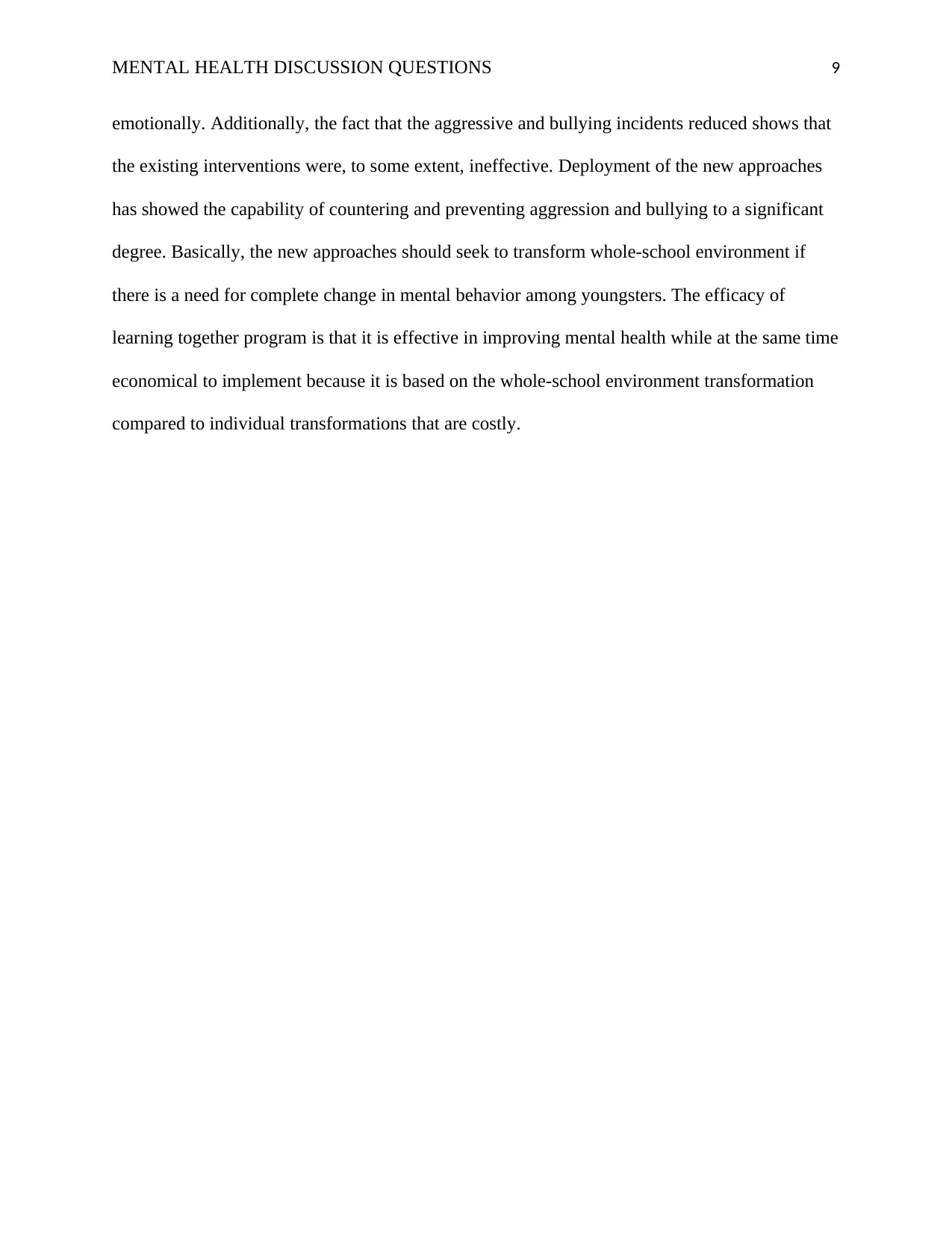
MENTAL HEALTH DISCUSSION QUESTIONS 9
emotionally. Additionally, the fact that the aggressive and bullying incidents reduced shows that
the existing interventions were, to some extent, ineffective. Deployment of the new approaches
has showed the capability of countering and preventing aggression and bullying to a significant
degree. Basically, the new approaches should seek to transform whole-school environment if
there is a need for complete change in mental behavior among youngsters. The efficacy of
learning together program is that it is effective in improving mental health while at the same time
economical to implement because it is based on the whole-school environment transformation
compared to individual transformations that are costly.
emotionally. Additionally, the fact that the aggressive and bullying incidents reduced shows that
the existing interventions were, to some extent, ineffective. Deployment of the new approaches
has showed the capability of countering and preventing aggression and bullying to a significant
degree. Basically, the new approaches should seek to transform whole-school environment if
there is a need for complete change in mental behavior among youngsters. The efficacy of
learning together program is that it is effective in improving mental health while at the same time
economical to implement because it is based on the whole-school environment transformation
compared to individual transformations that are costly.
⊘ This is a preview!⊘
Do you want full access?
Subscribe today to unlock all pages.

Trusted by 1+ million students worldwide

MENTAL HEALTH DISCUSSION QUESTIONS 10
References
Bonnell, C., Allen, E., Warren, E., McGowan, J.,., Bevilacqua, L., Jamal, F…Viner, M., R.
(2018). Effects of the learning together intervention on bullying and aggression in
English secondary schools: A cluster randomized controlled trial. The Lancet, 392(1).
References
Bonnell, C., Allen, E., Warren, E., McGowan, J.,., Bevilacqua, L., Jamal, F…Viner, M., R.
(2018). Effects of the learning together intervention on bullying and aggression in
English secondary schools: A cluster randomized controlled trial. The Lancet, 392(1).
1 out of 10
Related Documents
Your All-in-One AI-Powered Toolkit for Academic Success.
+13062052269
info@desklib.com
Available 24*7 on WhatsApp / Email
![[object Object]](/_next/static/media/star-bottom.7253800d.svg)
Unlock your academic potential
Copyright © 2020–2025 A2Z Services. All Rights Reserved. Developed and managed by ZUCOL.





